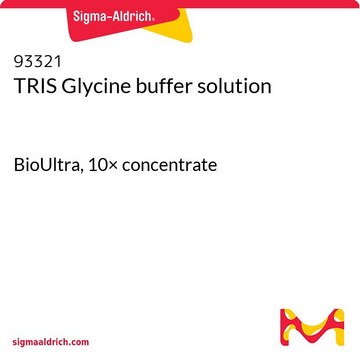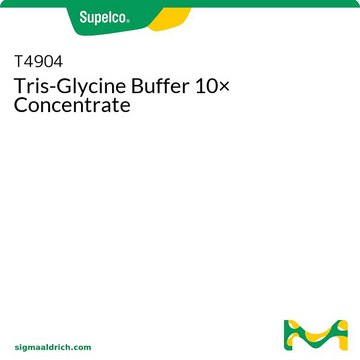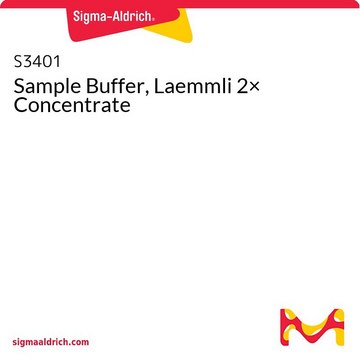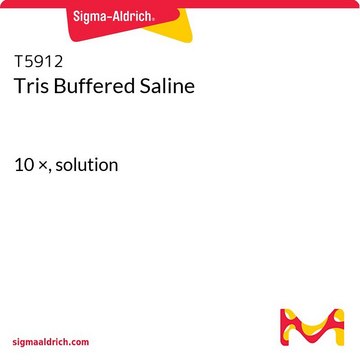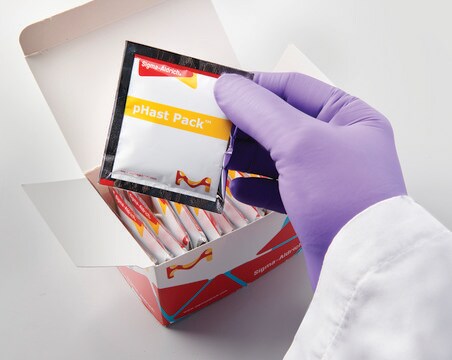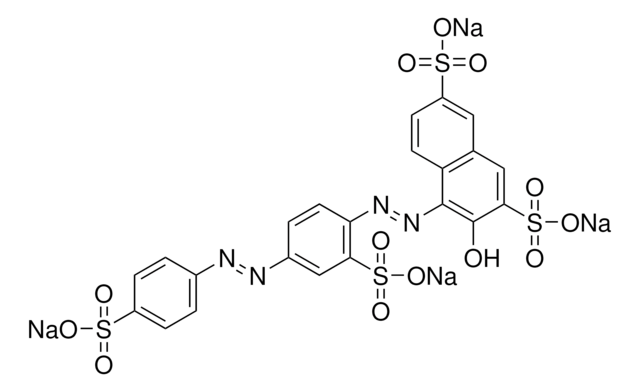T7777
TRIS glycine SDS buffe solution
Sinónimos:
TRIS glycine SDS buffer solution
Iniciar sesiónpara Ver la Fijación de precios por contrato y de la organización
About This Item
UNSPSC Code:
41105319
eCl@ss:
32129211
NACRES:
NA.25
Productos recomendados
sterility
0.2 μm filtered
Quality Level
form
liquid
application(s)
diagnostic assay manufacturing
storage temp.
2-8°C
¿Está buscando productos similares? Visita Guía de comparación de productos
General description
Tris-glycine-SDS (TGS) running buffer is the most commonly used buffer for sodium dodecyl sulfate-polyacrylamide gel electrophoresis (SDS-PAGE) of proteins. TGS is usually used for both anode and cathode buffer. Recommended running conditions is 150 volts for mini vertical gel electrophoresis units.
Application
Tris-glycine-SDS buffer 10× concentrate has been used as a running buffer in sodium dodecyl sulfate-polyacryamide gel electrophoresis (SDS-PAGE). It is also used to block membranes with 5% non-fat dry milk for western blotting. TGS is usually used for both the anode buffer and the cathode buffer. Recommended running conditions is 150 volts for mini vertical gel electrophoresis units.
Reconstitution
Dilution of the 10× TGS buffer produces a 1× running buffer containing 25 mM Tris, 192 mM glycine and 0.1% SDS, pH approx. 8.6.
Storage Class
10 - Combustible liquids
wgk_germany
WGK 1
flash_point_f
Not applicable
flash_point_c
Not applicable
ppe
Eyeshields, Gloves, type ABEK (EN14387) respirator filter
Elija entre una de las versiones más recientes:
¿Ya tiene este producto?
Encuentre la documentación para los productos que ha comprado recientemente en la Biblioteca de documentos.
Antitumor Activity and Mechanism of a Reverse Transcriptase Inhibitor, Dapivirine, in Glioblastoma
Liu W, et al.
Journal of Cancer, 117?128-117?128 (2018)
Multiple tandem epitope tagging for enhanced detection of protein expressed in mammalian cells
Zhang L, et al.
Molecular Biotechnology, 19(3), 313-321 (2001)
A Radioisotope-free Oligosaccharyltransferase Assay Method
Yamasaki T and Kohda D
Glycobiology (2007)
Man-Lan Guo et al.
Cell biochemistry and function, 37(2), 72-83 (2019-02-19)
Cancer cell progression and proliferation increase cell density, resulting in changes to the tumour site, including the microenvironment. What is not known is if increased cell density influences the aggressiveness of cancer cells, especially their proliferation, migration, and invasion capabilities.
Weiwen Liu et al.
The Journal of dermatology, 48(3), 289-300 (2020-12-02)
Androgenetic alopecia is the most common form of hair loss disorder. The features of this process are shortening of the anagen phase in hair cycling and progressive miniaturization of the hair follicle. However, the mechanisms in androgenetic alopecia are still
Nuestro equipo de científicos tiene experiencia en todas las áreas de investigación: Ciencias de la vida, Ciencia de los materiales, Síntesis química, Cromatografía, Analítica y muchas otras.
Póngase en contacto con el Servicio técnico